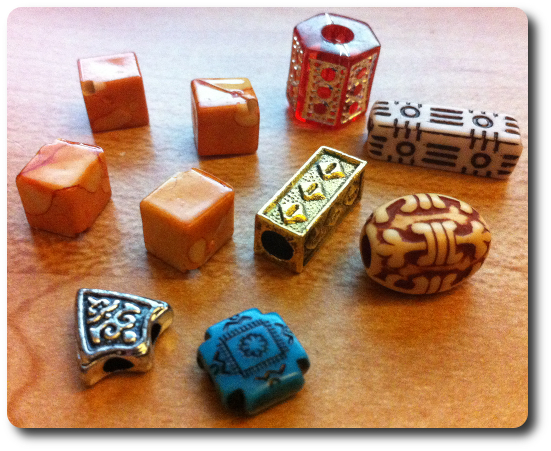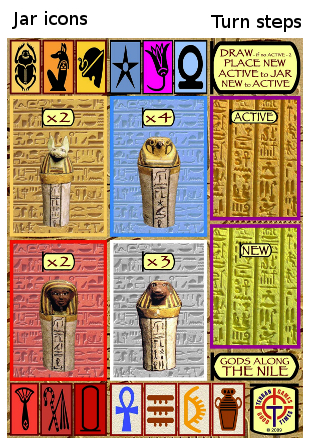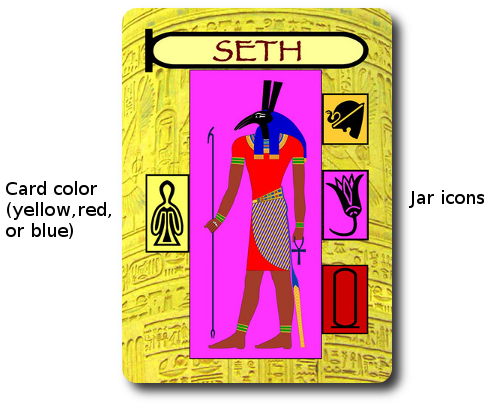
The Basics:
- For ages 8 and up (publisher suggests 10+)
- For 2 to 5 players
- Variable game length
Geek Skills:
- Active Listening & Communication
- Counting & Math
- Logical & Critical Decision Making
- Pattern/Color Matching
- Hand/Resource Management
- Bidding
Learning Curve:
- Child – Easy
- Adult – Easy
Theme & Narrative:
- Using sacred knowledge, gain favor from the Egyptian Gods to help your Pharaoh to the Afterlife
Endorsements:
- Gamer Geek approved!
- Parent Geek approved!
- Child Geek approved!
Overview
The Gods of Egypt are eternal and great. You know this better than anyone as you have dedicated your life to them and to your Pharaoh. You are the head priest of one of the many temples that can be found in Upper and Lower Egypt. Your position demands great respect and a heavy responsibility. For it is up to you to ensure the Pharaoh’s travel to the Afterlife is a safe and successful one.
Gods Along the Nile, by Terran Games, is comprised of 72 Egyptian Deity cards, 100 Scarab beads, 36 Blue Jar beads, 24 White Jar beads, 24 Green Jar beads, 24 Red Jar beads, 24 “One” Pharaoh beads, 10 “Five” Pharaoh beads, and 5 Temple player boards. The player boards are very thick, durable, and easy to read. The Deity cards are colorful and of typical thickness found in most card games, with illustrations that look like they were taken right from the walls of some long-lost Pharaoh’s tomb. The real story is the beads used in the game. Each Jar bead is unique and fun to play with. A silly thing to note, for certain, but when you play as many games as I do, you notice the little details.

Game Set Up
To set up the game, hand to each player a Temple player board.
Second, find the Seth Deity card and remove it from the deck. If playing a 2, 3, or 4-player game, find and remove all the cards with the white Eye of Horus icon on them. This keeps the deck size down and the games faster (or, keep them in if you want a longer game or playing with 5-players). There are also 3 “bonus cards” included in the game that have a black Eye of Horus. These can be kept in the game or removed and are only included to slightly increase the game length if so desired. Once any cards have been removed, shuffle the deck of remaining cards and deal to each player 3 cards, face-down. Players should look at their cards but keep them hidden from their opponents at all times. The deck of Deity cards is placed in the middle of the playing area, face-down, where all players can easily reach it.
Third, hand each player 5 Scarab beads. These are the block beads and are placed to one side to create the player’s initial Temple Treasury.
Place the remaining Jars, Pharaohs, and Scarab beads into common and separate piles in the middle of the playing area where all the players can easily reach it. We suggest little cups to keep things tidy at the gaming table.
Decide who will go first and begin!
A Quick Introduction to Your Temple
Players will be using their Temple player boards a great deal during the game. It helps them organize their Deity cards and beads. It also acts as a staging area for their Deity cards when they are played. The Temple player board is broken down into 6 different boxes where the Deity cards are placed. Above and below the “Jar” boxes are the Jar icons. To the upper right is the player turn step order summary for quick reference. To the far right is the “Active” and “New” boxes where Deity cards are staged.

The multipliers in the boxes identify how many Jar beads of that specific type are acquired by the player and the exchange rate when more Jar beads are being acquired during the scoring of a round.
Journey to the Afterlife
The game is played in rounds with each player taking turns. The beginning of each round starts with a bid to obtain Seth’s favor, the Egyptian God of Chaos and Storms, in hopes of winning an advantage over their opponents by always having one more card then the other players. The bid starts with the first player who can pass or start the bid with any value they could pay for using their Scarab beads. During the first round of the game, the player can bid all 5 of their Scarab beads and automatically end the bid (as no other player can bid more than 5). Otherwise, the bidding for Seth’s favor follows standard bidding practices, where a player can either pass or increase the previous bid. Once all the player’s pass or no other bids are offered, the winner collects the Seth Deity card and places it in their hand. A number of Scarab beads equal to their bid are placed in the common Scarab bead pile. Once the bidding has concluding, each player now plays out the duration of the round by taking turns.
A player’s turn is broken down into four sequential steps which are summarized here and are also listed on the Temple player boards for easy reference. Once the player is done with their turn, the next player going clockwise has their turn. This continues until the round ends.
Step 1: Draw a Deity Card
The fist step on a player’s turn is to draw a Deity card from the deck. Only one card is drawn unless the player doesn’t have a Deity card played to their Temple’s “Active” box. If they do not, they draw 2 Deity cards. Note that a player will always draw 2 Deity cards on their first turn and will only be able to draw 2 cards during the round if they are unable to play a card. If no cards are available to draw, the player skips this step. There is no hand size limit.
Step 2: Place a New Card
The second step on a player’s turn is to play any one Deity card from their hand to the Temple’s “New” box. The only restriction is the card color. A card of the same color as played by the opponent who just finished their turn is off-limits. For example, if the player’s opponent played a red Deity card, the player can only play blue or yellow Deity cards. If the player is unable to play a card, this step is skipped.
Some Deity cards have the chaos icon (icon looks like a purple papyrus flower). Individually, these icons work just like any other Deity card icon. However, if there are ever 3 chaos icons in play and visible on any Temple player boards, the round ends. Players are directed to announce to the table a new chaos icon when played to the Temple player board.
Step 3: Move Active Deity Cards to a Jar Box
The third step on a player’s turn is to move the Deity card in their Temple’s “Active” box to any of the four Temple “Jar” boxes. Every Deity card will have a series of icons on it that match one or more of the “Jar” box icons. When a player moves their Deity card to one of the Temple “Jar” boxes, it is placed on top of any previously placed Deity card, canceling any chaos icons shown. The player now collects one Scarab bead for each of the Temple “Jar” box icons that matches one or more of the same icons on the Deity card. The Scarab beads are placed on the Temple “Jar” box icons on the Temple player board that match the Deity card.

There is no limit to the number of Scarab beads the Temple “Jar” box icons can hold. However, when a player has at least 1 Scarab bead on each of the Temple “Jar” box icons spaces under one of the “Jar” boxes, the player has created a Jar Set. The Scarab beads that comprise the Jar Set are exchanged for two or more Jar bead that matches the Temple “Jar” color (red, blue, white, or brown). Each Temple “Jar” box has a multiplier (x2, x3, or x4). The multiplier determines the number of Jar beads acquired by completing a Jar Set. The newly acquired Jar beads and any remaining Scarab beads not included in the Jar Set are placed in the player’s Temple Treasury.
Some Deity cards have a small icon that makes it a “wild” Deity card. Wild Deity cards are played as any other Deity card, but when placed on a Temple “Jar” box, they automatically give the player 1 Jar bead that matches the color of the Temple “Jar” box. This is in addition to providing any Scarab beads or Jar beads acquired through a Jar Set.
Step 4: Move Deity Card from the New Box to the Active Box
The fourth and final step on a player’s turn is to shift their Deity card in the Temple;s “New” box to the Temple’s “Active” box. This Deity card will be the one moved to a Temple “Jar” box on the player’s next turn.
Ending the Round and Round Scoring
The round ends one of two different ways. The first is if there are ever 3 chaos icons across all the Temple player boards. The second is if the last Deity card is drawn. Regardless of how the round ends, all the players are given one final turn. If a turn step is unavailable, the player just skips it.
Once all the players have completed their turns, their Temple player boards are cleared. All Deity cards and any unclaimed Scarab beads are removed. Place the unclaimed Scarab beads into the common Scarab pile. The Deity cards are set aside.
The players now take all their Jar and Scarab beads in their Temple Treasury and place them on their Temple player board. The Jar beads are placed on their matching Temple “Jar” boxes and the Scarab beads are placed on the Temple’s “Active” box. The players now exchanges 4 different Jar beads for a single Pharaoh Set (1 blue, 1 red, 1 white, and 1 brown Jar bead = 1 Pharaoh). For every Pharaoh Set they create, they place the Jar beads used into their respective common piles and acquire 1 Pharaoh bead that goes into their Temple Treasury. Note that a player can exchange 5 single smaller Pharaoh beads for one larger Pharaoh bead that is equal to five individual Pharaoh beads when counted.
During rounds one and two, every Pharaoh Set gives the player a bonus Scarab bead. This Scarab bead is added to the player’s Scarab bead pile on their Temple’s “Active” box. Once the player completes any Pharaoh Sets using their Jar beads, they can then exchange their Scarab beads to acquire needed Jar beads. The cost of each Jar bead in Scarab beads is equal to the multiplier on the Temple “Jar” box. For example, a player can exchange 3 Scarab beads for 1 white Jar bead. Scarab beads used in the exchange are placed in the common Scarab pile. This continues until the player can no longer exchange Scarab beads to acquire Jar beads to create Pharaoh Sets. Any unused Jars and Scarabs are returned to the player’s Temple Treasury.
Once every player has completed their exchanges, the next round begins.
Ending the Game
On the third and final round, the players exchange their Scarab and Jar beads as they did in the fist and second round with two exceptions. First, and already mentioned, the third round does not award players Scarab beads for completing Pharaoh Sets. Second, the players can exchange multiple Jar beads of one color to acquire a single Jar bead of a different color. The cost of each Jar bead is equal to the multiplier on the Temple “Jar” box. For example, a player can exchange 3 Jar beads of colors red, blue, or brown for 1 white Jar bead. Jar beads used in the exchange are placed in their respective common Jar piles. This continues until the players have completed all their exchanges and created as many Pharaoh Sets as possible.
The players now add up all their acquired Pharaoh beads. The player with the most Pharaoh beads wins the game.
To learn more about Gods Along the Nile, visit the game’s web page.
Prediction
Gods Along the Nile doesn’t appear to be a complicated game. The players do not directly compete with each other which will allow players to focus in on their own game and playing style. At most, a player can think two moves ahead (cards placed in the “Active” and “New” boxes on the Temple player board), and are only slightly limited by what their opponent played before them. Where the game’s complexity comes into play is the management and acquiring of Scarabs and Jars. The players will need to put some thought into what cards they want to play or they run the risk of not acquiring much of anything for the entire round. In other words, you can’t just play cards randomly.
The game also allows players to end the game prematurely. I have always enjoyed games like this because it allows for players to indirectly impact another player’s score. This means all players will have to keep one eye on their opponents and make some smart choices regarding their card plays with chaos icons. From a Child Geek’s perspective, I think this game mechanism will be lost on them (preferring to keep the game going as long as possible to gain as many beads as possible), but the game itself should be enjoyable. I also don’t see the Parent Geeks disliking this game as it is fairly straightforward in game play and has enough depth to engage, but light enough to be casual. The Gamer Geeks are a tough call. The game does have some very interesting game mechanisms in it, but the game lacks much in the way of strategy or tactics. Critical thinking is a must, however, so it might appeal to the Gamer Geeks as a light resource card game. We’ll just have to see.
Teaching the game doesn’t take long, but is probably best done with a quick example or two. This is especially true when it comes to playing the Deity cards to the Temple “Jar” boxes. For all of our groups, it only took one demonstration and everyone was ready to play. The Child Geeks did have a few questions on the exchange rate, but this was again easily addressed with a quick demonstration. None of our players were ever lost or confused and everyone was eager to play.
And so, after teaching the game to my oldest little geek, I asked him his thoughts on Gods Along the Nile so far.
“I like the cards and love the beads. I don’t think this is going to be a hard game to learn or to beat you at, Dad.” ~ Liam (age 8)
Love the confidence! Let’s play the game and see if it lives up to our expectations.
Final Word
The Child Geeks very much enjoyed this game, but I wasn’t sure if they liked it or not at first as they stayed unusually quite. As soon as they started to collect the Jar beads, however, their typical levels of excitement became visible. What the Child Geeks liked the most, funny enough, were the beads. The act of collecting the beads made perfect sense to them and they utilized the Deity cards very well to acquire them. What was not observed during the game were any of the Child Geeks purposely ending a game round. I don’t know if this was done on purpose or they were too caught up in acquiring beads to notice they were overlaying (and thus removing) existing Deity cards with the chaos icon. Either way, all the Child Geeks we played the game with loved it.

My little geek proudly shows me his acquired beads
The Parent Geeks also had a lot of fun with this game, both with their Child Geeks and with their peers. The game play is very straight forward and with the right players can be very fast. Analysis paralysis in this game was almost zero, with only a few of the Child Geeks and non-gamers spending a bit too much time looking at their cards. Regardless, the Parent Geeks thought the game was very well designed, had excellent components, and provided an engaging and worthwhile game playing experience.
The Gamer Geeks took a long time to warm up to this game. They understood the rules immediately and mistakenly took it to be a simple color and pattern matching exercise. While that aspect of game play is there, it is much deeper than that. To play the game well, players must “load” their “Jar” boxes with as many Scarab beads as possible before completing a Jar Set. This gives the player a great deal of Scarab beads to use during the end of the round, as well as a lot of bidding power. The Gamer Geeks started to see Gods Along the Nile as a well thought out resource management and set collecting game with multiple stages and paths to victory. They especially liked how you could end a round, but had to work for it, giving everyone a chance to end the round on their terms, but not easily. While light when compared to the other games they usually played, they nevertheless found Gods Along the Nile to be a game you had to think about and use some clever hand management to come out on top. That was enough for them to enjoy and approve the game.
I really like this game. It’s playable with Child Geeks and Gamer Geeks, easy to teach to the non-gamers, and provides engaging casual game play for everyone. The game component are very nice and it was fun to collect the different Jar beads. The game did feel a bit long at times with only 2 players, especially when neither wanted to end the round prematurely, but this usually resolved itself with a quick and very cutthroat third round of play. I would recommend Gods Along the Nile to any Gamer Geek elitist who was looking for a light resource card game, to Parent Geeks who wanted a game to play with the family, and to any Child Geek who enjoyed card games and were looking for something more challenging. The only aspect of the game I did not enjoy was the multiplier for the Jar Sets being covered up by the Deity cards. When you play with 4 or less players, this is easily solved with just placing the extra Temple player board to one side for quick reference. When playing a 5-player game, you are forced to move your cards each time you want to look at the modifier. A small annoyance at best and one that can easily be addressed by simply writing the modifiers down on a piece of papyrus.
This game was given to Father Geek as a review copy. Father Geek was not paid, bribed, wined, dined, or threatened in vain hopes of influencing this review. Such is the statuesque and legendary integrity of Father Geek.



